Abstract
Physicians should seek to enhance the quality rather than the quantity of human life. Physical activity programs can increase life satisfaction through an immediate increase of arousal and a long-term enhancement of self-esteem and body image. In the young child competition can cause excessive arousal, but long-term adverse effects are rare. In the adult a reduction of anxiety and stress and a general feeling of well-being reduce the frequency of minor medical complaints, generating important economic benefits. Physical activity programs also help to correct the reactive depression that accompanies conditions such as myocardial infarction. Interest in physical activity should be stimulated from the earliest years of primary school. The allocation of curricular time to physical education does not hamper academic achievement. Rather, through its impact on psychomotor learning, it enhances the total process of intellectual and psychomotor development.
Full text
PDF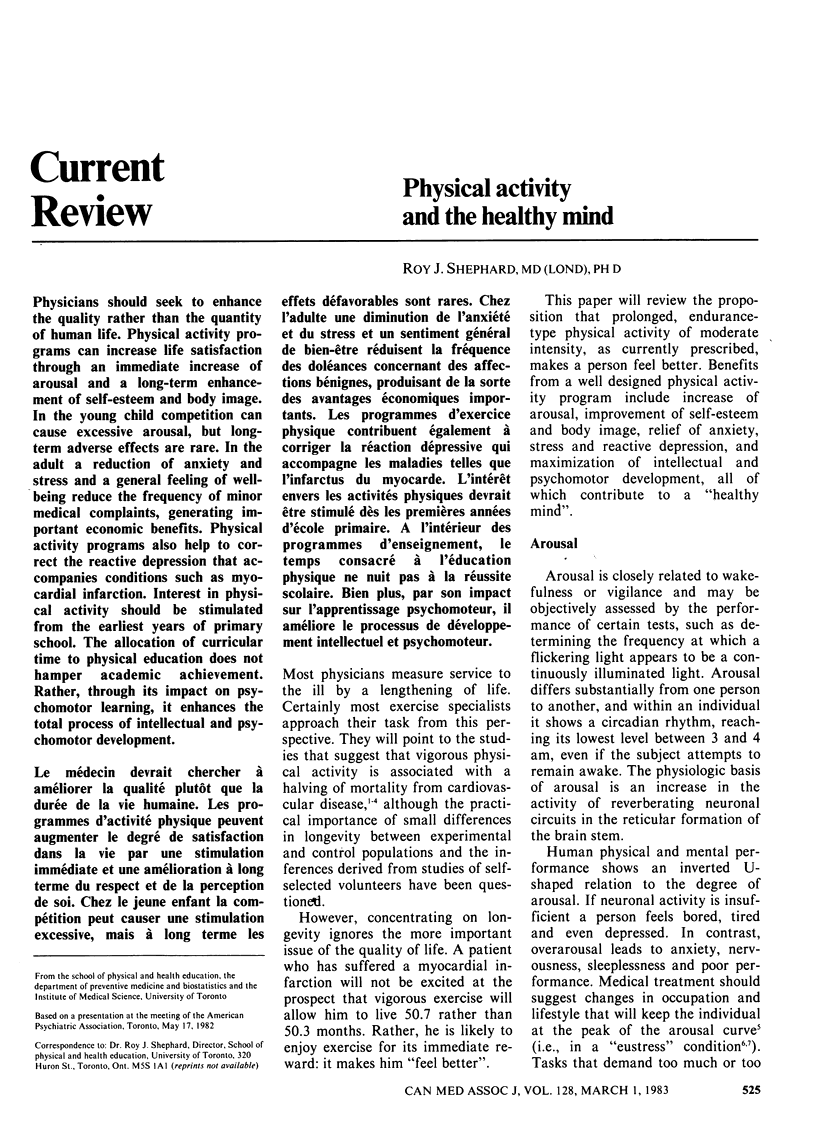
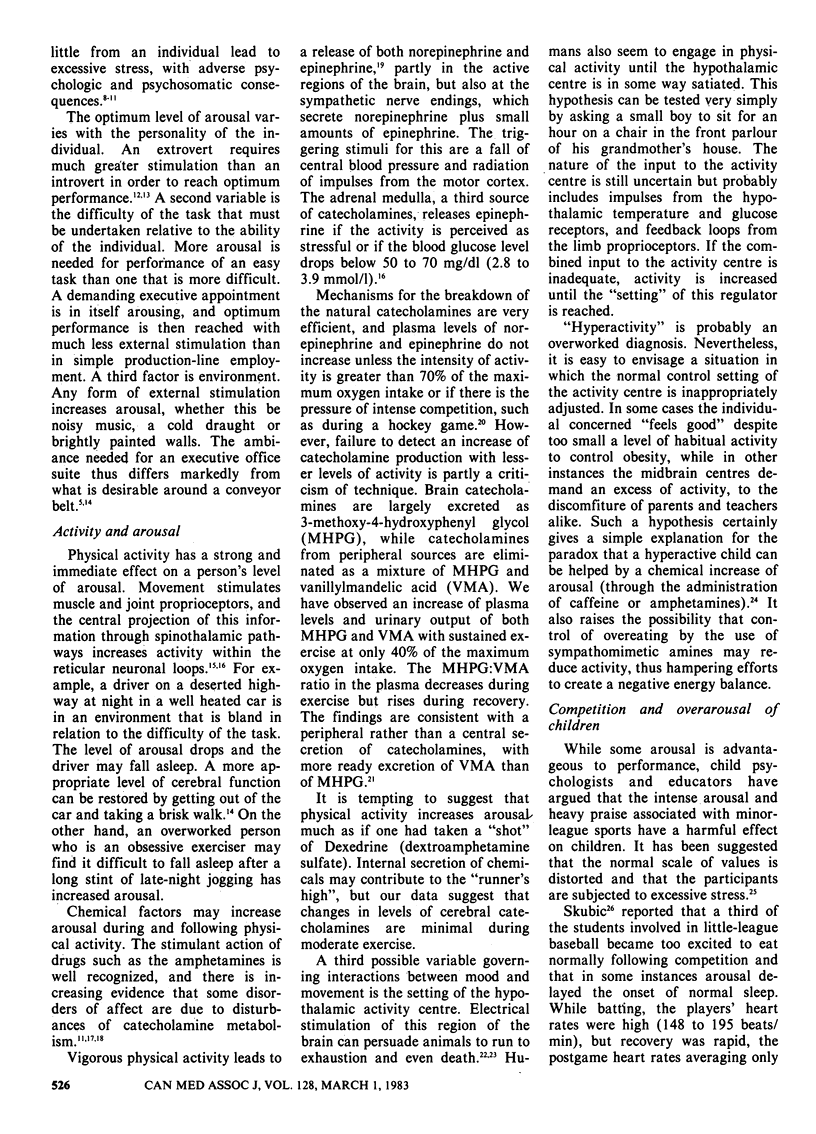
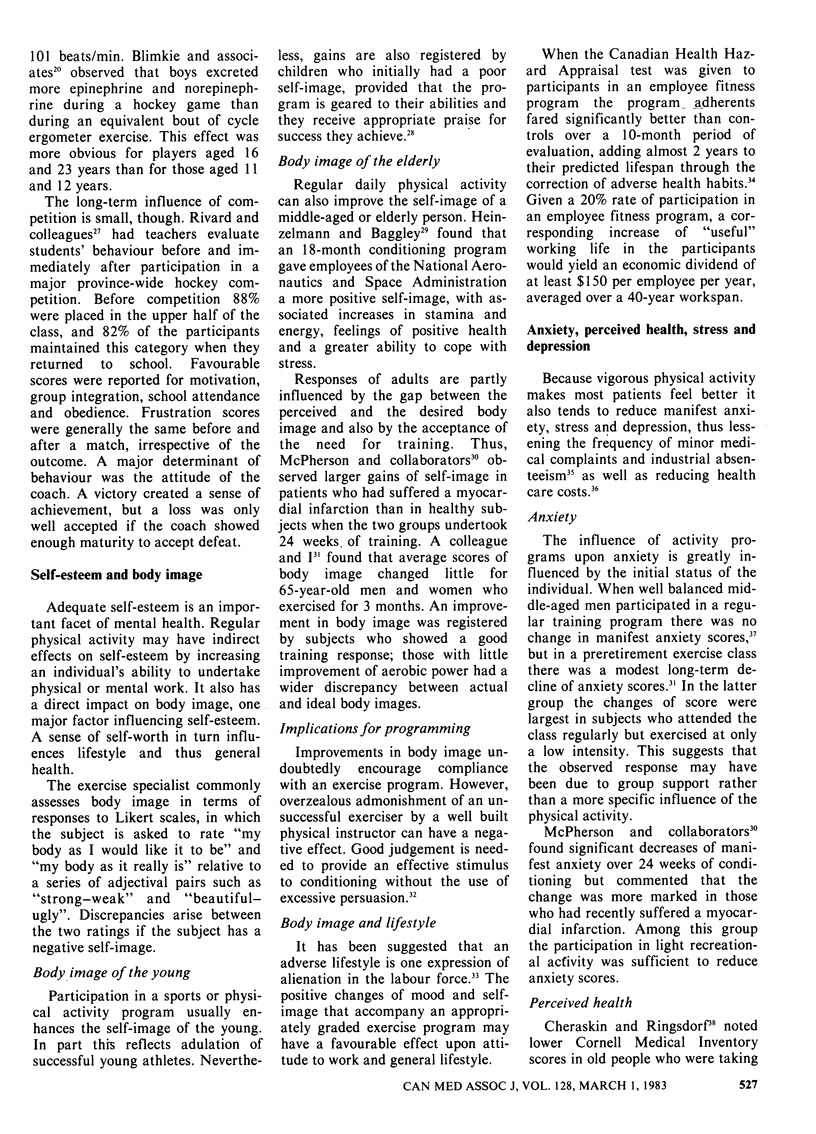
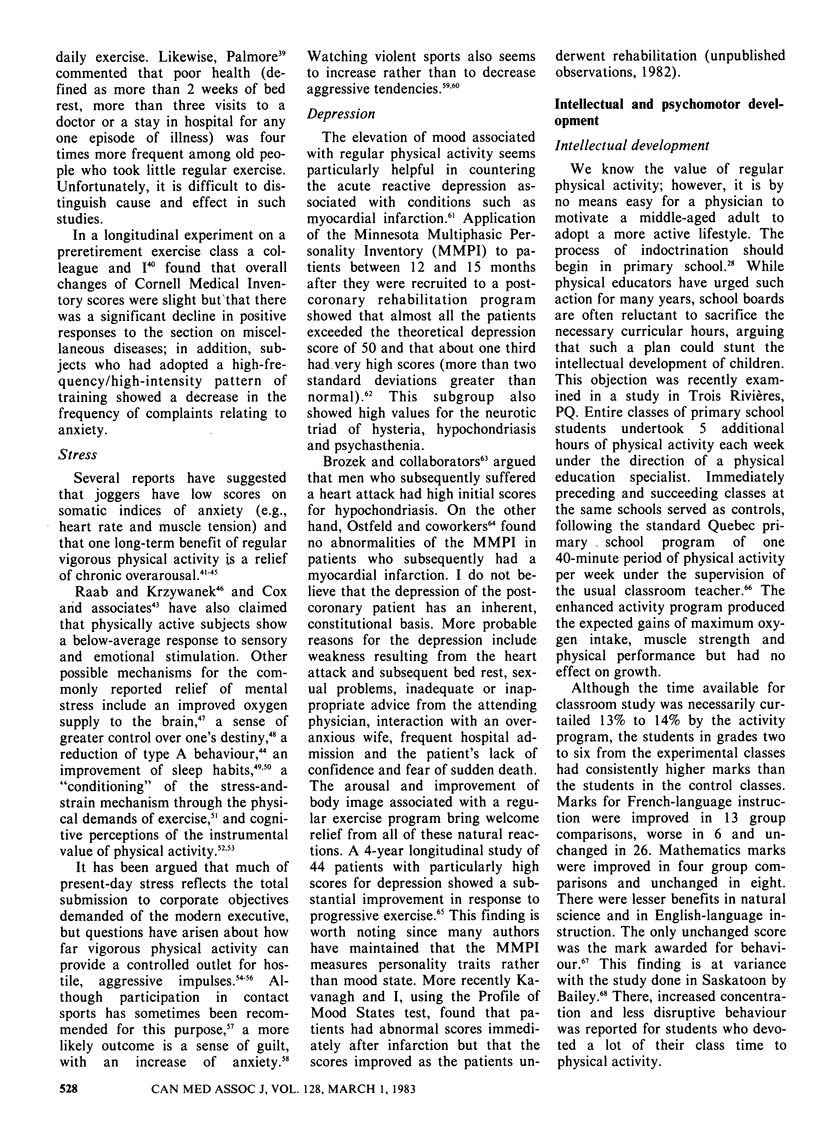
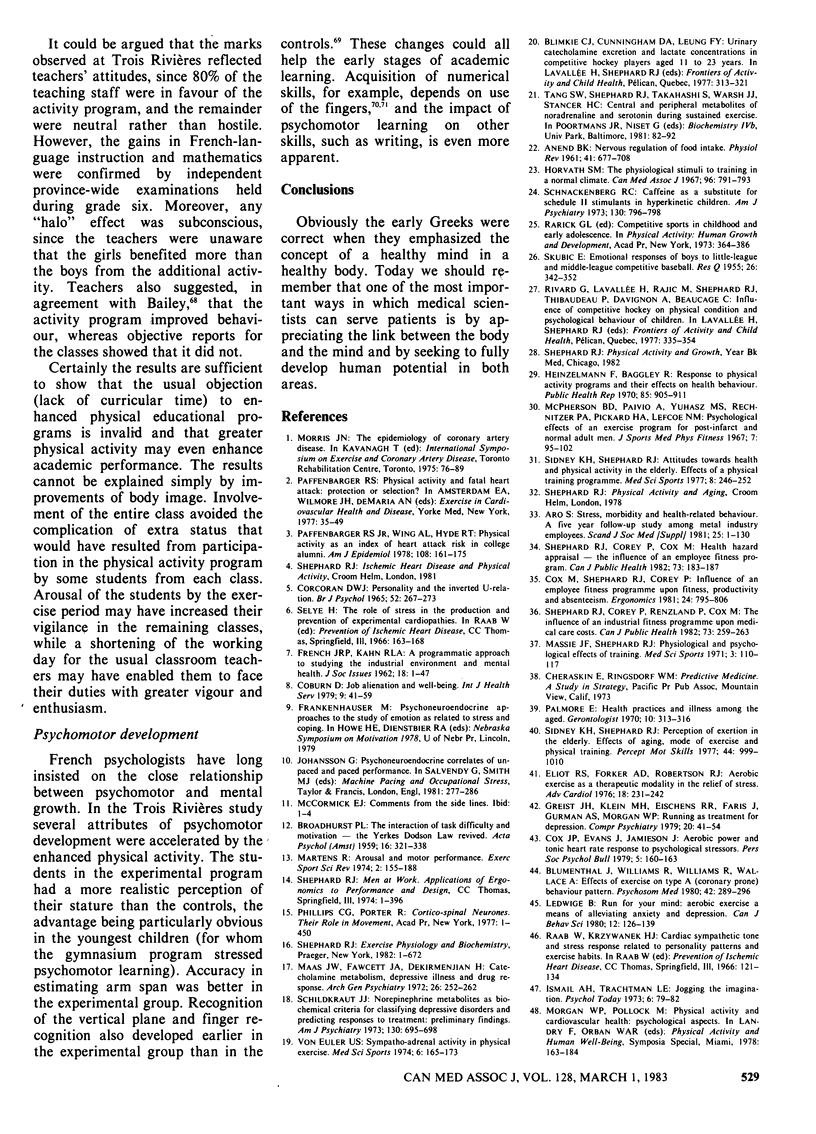
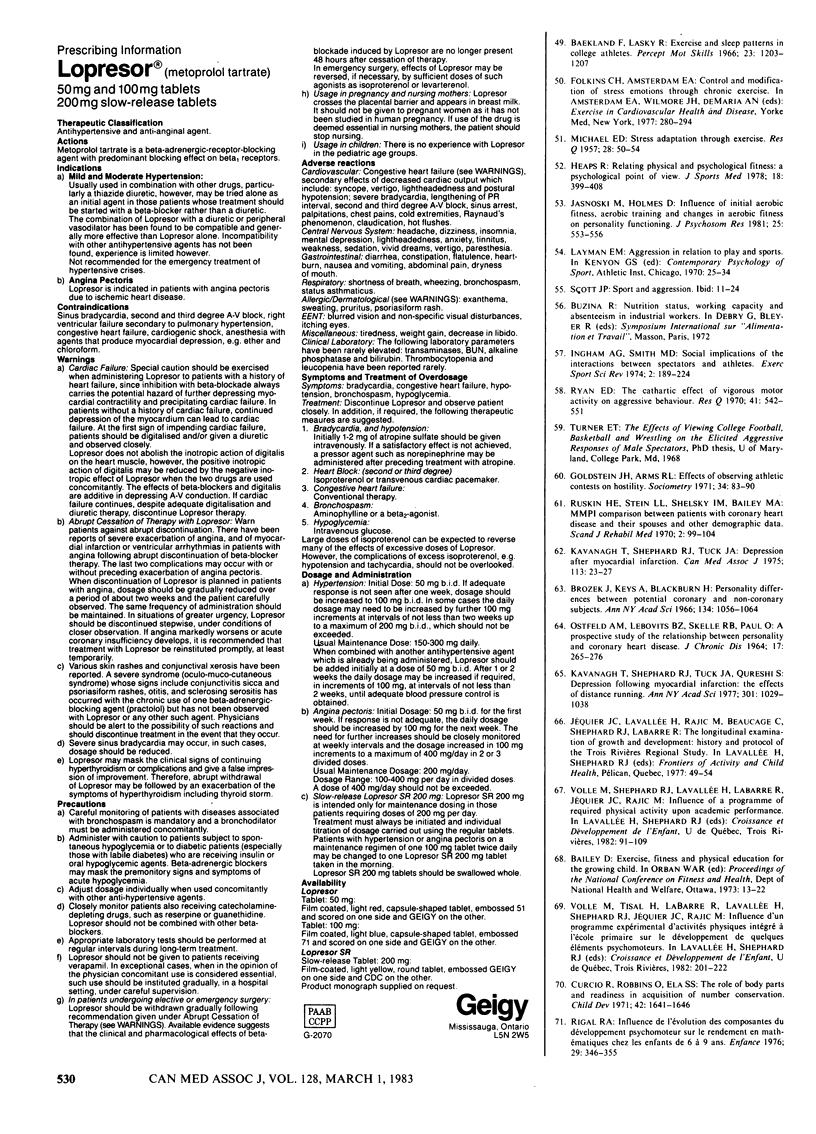
Selected References
These references are in PubMed. This may not be the complete list of references from this article.
- ANAND B. K. Nervous regulation of food intake. Physiol Rev. 1961 Oct;41:677–708. doi: 10.1152/physrev.1961.41.4.677. [DOI] [PubMed] [Google Scholar]
- Aro S. Stress, morbidity, and health-related behaviour. A five-year follow-up study among metal industry employees. Scand J Soc Med Suppl. 1981;25:1–130. [PubMed] [Google Scholar]
- Baekeland F., Lasky R. Exercise and sleep patterns in college athletes. Percept Mot Skills. 1966 Dec;23(3):1203–1207. doi: 10.2466/pms.1966.23.3f.1203. [DOI] [PubMed] [Google Scholar]
- Blumenthal J. A., Williams R. S., Williams R. B., Jr, Wallace A. G. Effects of exercise on the Type A (coronary prone) behavior pattern. Psychosom Med. 1980 Mar;42(2):289–296. doi: 10.1097/00006842-198003000-00006. [DOI] [PubMed] [Google Scholar]
- CORCORAN D. W. PERSONALITY AND THE INVERTED-U RELATION. Br J Psychol. 1965 Aug;56:267–273. doi: 10.1111/j.2044-8295.1965.tb00964.x. [DOI] [PubMed] [Google Scholar]
- Coburn D. Job alienation and well-being. Int J Health Serv. 1979;9(1):41–59. doi: 10.2190/L743-W4EV-2F8J-C1K0. [DOI] [PubMed] [Google Scholar]
- Cox M., Shephard R. J., Corey P. INfluence of an employee fitness programme upon fitness, productivity and absenteeism. Ergonomics. 1981 Oct;24(10):795–806. doi: 10.1080/00140138108924900. [DOI] [PubMed] [Google Scholar]
- Eliot R. S., Forker A. D., Robertson R. J. Aerobic exercise as a therapeutic modality in the relief of stress. Adv Cardiol. 1976;18(0):231–242. doi: 10.1159/000399527. [DOI] [PubMed] [Google Scholar]
- Goldstein J. H., Arms R. L. Effects of observing athletic contests on hostility. Sociometry. 1971 Mar;34(1):83–90. [PubMed] [Google Scholar]
- Greist J. H., Klein M. H., Eischens R. R., Faris J., Gurman A. S., Morgan W. P. Running as treatment for depression. Compr Psychiatry. 1979 Jan-Feb;20(1):41–54. doi: 10.1016/0010-440x(79)90058-0. [DOI] [PubMed] [Google Scholar]
- Heinzelmann F., Bagley R. W. Response to physical activity programs and their effects on health behavior. Public Health Rep. 1970 Oct;85(10):905–911. [PMC free article] [PubMed] [Google Scholar]
- Ingham A. G., Smith M. D. Social implications of the interaction between spectators and athletes. Exerc Sport Sci Rev. 1974;2:189–224. [PubMed] [Google Scholar]
- Jasnoski M. L., Holmes D. S. Influence of initial aerobic fitness, aerobic training and changes in aerobic fitness on personality functioning. J Psychosom Res. 1981;25(6):553–556. doi: 10.1016/0022-3999(81)90109-4. [DOI] [PubMed] [Google Scholar]
- Kavanagh T., Shephard R. J., Tuck J. A. Depression after myocardial infarction. Can Med Assoc J. 1975 Jul 12;113(1):23–27. [PMC free article] [PubMed] [Google Scholar]
- Kavanagh T., Shephard R. J., Tuck J. A., Qureshi S. Depression following myocardial infarction: the effects of distance running. Ann N Y Acad Sci. 1977;301:1029–1038. doi: 10.1111/j.1749-6632.1977.tb38267.x. [DOI] [PubMed] [Google Scholar]
- Maas J. W., Fawcett J. A., Dekirmenjian H. Catecholamine metabolism, depressive illness, and drug response. Arch Gen Psychiatry. 1972 Mar;26(3):252–262. doi: 10.1001/archpsyc.1972.01750210060012. [DOI] [PubMed] [Google Scholar]
- Martens R. Arousal and motor performance. Exerc Sport Sci Rev. 1974;2:155–188. [PubMed] [Google Scholar]
- Massie J. F., Shephard R. J. Physiological and psychological effects of training--a comparison of individual and gymnasium programs, with a characterization of the exercise "drop-out". Med Sci Sports. 1971 Fall;3(3):110–117. [PubMed] [Google Scholar]
- McPherson B. D., Paivio A., Yuhasz M. S., Rechnitzer P. A., Pickard H. A., Lefcoe N. M. Psychological effects of an exercise program for post-infarct and normal adult men. J Sports Med Phys Fitness. 1967 Jun;7(2):95–102. [PubMed] [Google Scholar]
- OSTFELD A. M., LEBOVITS B. Z., SHEKELLE R. B., PAUL O. A PROSPECTIVE STUDY OF THE RELATIONSHIP BETWEEN PERSONALITY AND CORONARY HEART DISEASE. J Chronic Dis. 1964 Mar;17:265–276. [PubMed] [Google Scholar]
- Paffenbarger R. S., Jr, Wing A. L., Hyde R. T. Physical activity as an index of heart attack risk in college alumni. Am J Epidemiol. 1978 Sep;108(3):161–175. doi: 10.1093/oxfordjournals.aje.a112608. [DOI] [PubMed] [Google Scholar]
- Palmore E. Health practices and illness among the aged. Gerontologist. 1970 Winter;10(4):313–316. doi: 10.1093/geront/10.4_part_1.313. [DOI] [PubMed] [Google Scholar]
- Phillips C. G., Porter R. Corticospinal neurones. Their role in movement. Monogr Physiol Soc. 1977;(34):v-xii, 1-450. [PubMed] [Google Scholar]
- Ruskin H. D., Stein L. L., Shelsky I. M., Bailey M. A., Jefferson G. E., Braverman E. I., Zatzkin J. A. MMPI: comparison between patients with coronary heart disease and their spouses together with other demographic data. A preliminary report. Scand J Rehabil Med. 1970;2(2):99–104. [PubMed] [Google Scholar]
- Ryan E. D. The cathartic effect of vigorous motor activity on agresive behavior. Res Q. 1970 Dec;41(4):542–551. [PubMed] [Google Scholar]
- Schildkraut J. J. Norepinephrine metabolites as biochemical criteria for classifying depressive disorders and predicting responses to treatment: preliminary findings. Am J Psychiatry. 1973 Jun;130(6):695–699. doi: 10.1176/ajp.130.6.695. [DOI] [PubMed] [Google Scholar]
- Schnackenberg R. C. Caffeine as a substitute for Schedule II stimulants in hyperkinetic children. Am J Psychiatry. 1973 Jul;130(7):796–798. doi: 10.1176/ajp.130.7.796. [DOI] [PubMed] [Google Scholar]
- Shephard R. J., Corey P., Cox M. Health hazard appraisal--the influence of an employee fitness program. Can J Public Health. 1982 May-Jun;73(3):183–187. [PubMed] [Google Scholar]
- Shephard R. J., Corey P., Renzland P., Cox M. The influence of an employee fitness and lifestyle modification program upon medical care costs. Can J Public Health. 1982 Jul-Aug;73(4):259–263. [PubMed] [Google Scholar]
- Sidney K. H., Shephard R. J. Attitudes towards health and physical activity in the elderly. Effects of a physical training program. Med Sci Sports. 1976 Winter;8(4):246–252. [PubMed] [Google Scholar]
- Sidney K. H., Shephard R. J. Perception of exertion in the elderly, effects of aging, mode of exercise and physical training. Percept Mot Skills. 1977 Jun;44(3 Pt 1):999–1010. doi: 10.2466/pms.1977.44.3.999. [DOI] [PubMed] [Google Scholar]
- Von Euler U. S. Sympatho-adrenal activity inphysical exercise. Med Sci Sports. 1974 Fall;6(3):165–173. [PubMed] [Google Scholar]


